ESP Lancia Thesis 2006 Owner handbook (in English)
[x] Cancel search | Manufacturer: LANCIA, Model Year: 2006, Model line: Thesis, Model: Lancia Thesis 2006Pages: 386, PDF Size: 8.69 MB
Page 84 of 386
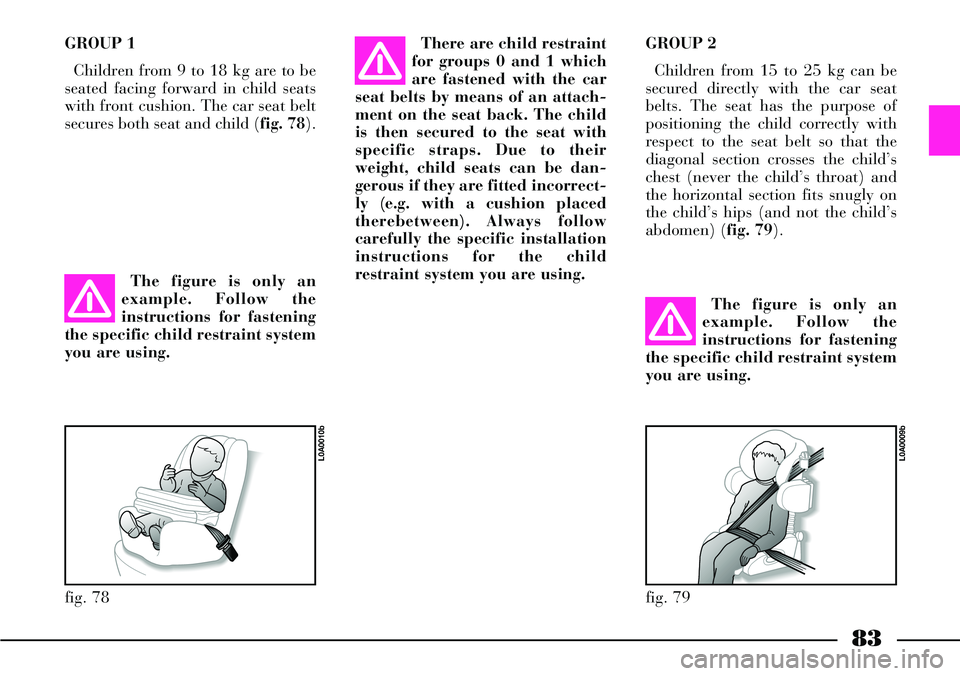
83
GROUP 1
Children from 9 to 18 kg are to be
seated facing forward in child seats
with front cushion. The car seat belt
secures both seat and child (fig. 78).There are child restraint
for groups 0 and 1 which
are fastened with the car
seat belts by means of an attach-
ment on the seat back. The child
is then secured to the seat with
specific straps. Due to their
weight, child seats can be dan-
gerous if they are fitted incorrect-
ly (e.g. with a cushion placed
therebetween). Always follow
carefully the specific installation
instructions for the child
restraint system you are using.GROUP 2
Children from 15 to 25 kg can be
secured directly with the car seat
belts. The seat has the purpose of
positioning the child correctly with
respect to the seat belt so that the
diagonal section crosses the child’s
chest (never the child’s throat) and
the horizontal section fits snugly on
the child’s hips (and not the child’s
abdomen) (fig. 79).
The figure is only an
example. Follow the
instructions for fastening
the specific child restraint system
you are using.The figure is only an
example. Follow the
instructions for fastening
the specific child restraint system
you are using.
fig. 78
L0A0010b
fig. 79
L0A0009b
Page 90 of 386
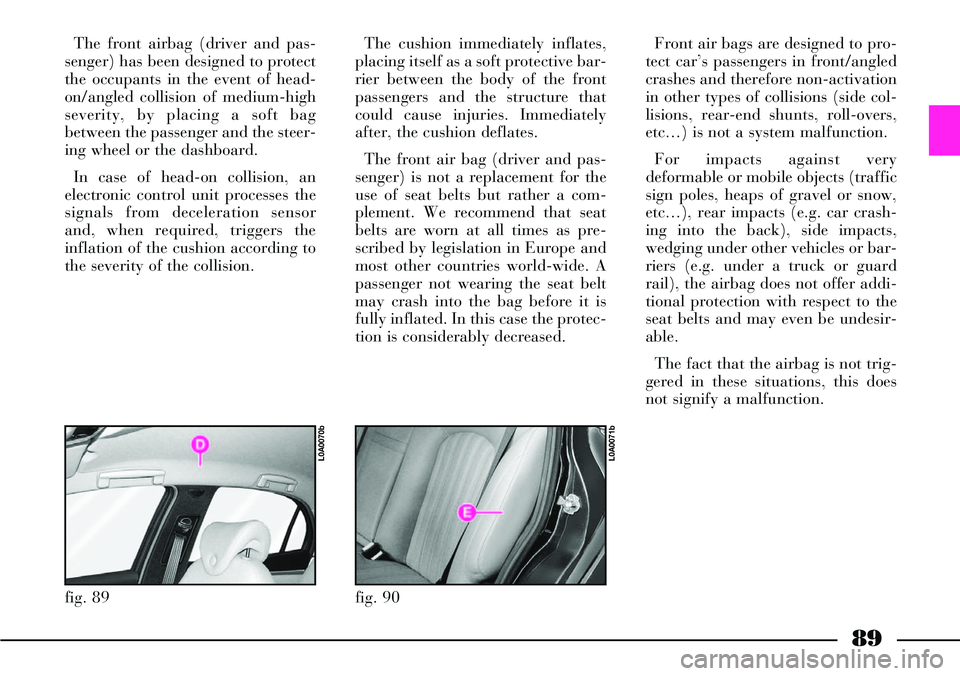
89
The front airbag (driver and pas-
senger) has been designed to protect
the occupants in the event of head-
on/angled collision of medium-high
severity, by placing a soft bag
between the passenger and the steer-
ing wheel or the dashboard.
In case of head-on collision, an
electronic control unit processes the
signals from deceleration sensor
and, when required, triggers the
inflation of the cushion according to
the severity of the collision.
fig. 89
L0A0070b
The cushion immediately inflates,
placing itself as a soft protective bar-
rier between the body of the front
passengers and the structure that
could cause injuries. Immediately
after, the cushion deflates.
The front air bag (driver and pas-
senger) is not a replacement for the
use of seat belts but rather a com-
plement. We recommend that seat
belts are worn at all times as pre-
scribed by legislation in Europe and
most other countries world-wide. A
passenger not wearing the seat belt
may crash into the bag before it is
fully inflated. In this case the protec-
tion is considerably decreased.
fig. 90
L0A0071b
Front air bags are designed to pro-
tect car’s passengers in front/angled
crashes and therefore non-activation
in other types of collisions (side col-
lisions, rear-end shunts, roll-overs,
etc…) is not a system malfunction.
For impacts against very
deformable or mobile objects (traffic
sign poles, heaps of gravel or snow,
etc…), rear impacts (e.g. car crash-
ing into the back), side impacts,
wedging under other vehicles or bar-
riers (e.g. under a truck or guard
rail), the airbag does not offer addi-
tional protection with respect to the
seat belts and may even be undesir-
able.
The fact that the airbag is not trig-
gered in these situations, this does
not signify a malfunction.
Page 93 of 386
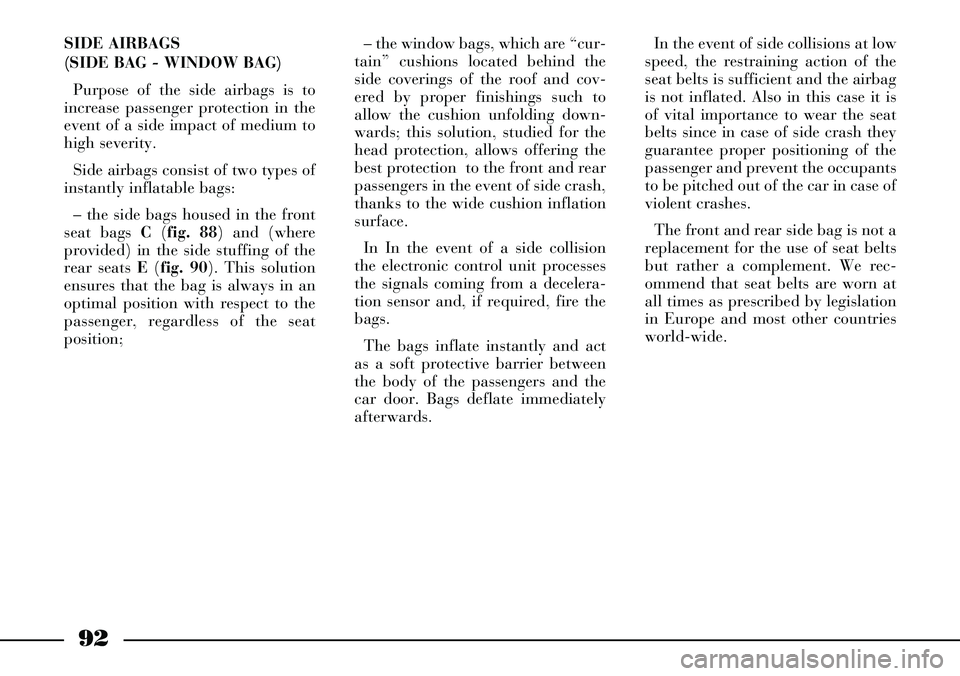
In the event of side collisions at low
speed, the restraining action of the
seat belts is sufficient and the airbag
is not inflated. Also in this case it is
of vital importance to wear the seat
belts since in case of side crash they
guarantee proper positioning of the
passenger and prevent the occupants
to be pitched out of the car in case of
violent crashes.
The front and rear side bag is not a
replacement for the use of seat belts
but rather a complement. We rec-
ommend that seat belts are worn at
all times as prescribed by legislation
in Europe and most other countries
world-wide.
92
SIDE AIRBAGS
(SIDE BAG - WINDOW BAG)
Purpose of the side airbags is to
increase passenger protection in the
event of a side impact of medium to
high severity.
Side airbags consist of two types of
instantly inflatable bags:
– the side bags housed in the front
seat bags C (fig. 88) and (where
provided) in the side stuffing of the
rear seats E (fig. 90). This solution
ensures that the bag is always in an
optimal position with respect to the
passenger, regardless of the seat
position;– the window bags, which are “cur-
tain” cushions located behind the
side coverings of the roof and cov-
ered by proper finishings such to
allow the cushion unfolding down-
wards; this solution, studied for the
head protection, allows offering the
best protection to the front and rear
passengers in the event of side crash,
thanks to the wide cushion inflation
surface.
In In the event of a side collision
the electronic control unit processes
the signals coming from a decelera-
tion sensor and, if required, fire the
bags.
The bags inflate instantly and act
as a soft protective barrier between
the body of the passengers and the
car door. Bags deflate immediately
afterwards.
Page 99 of 386
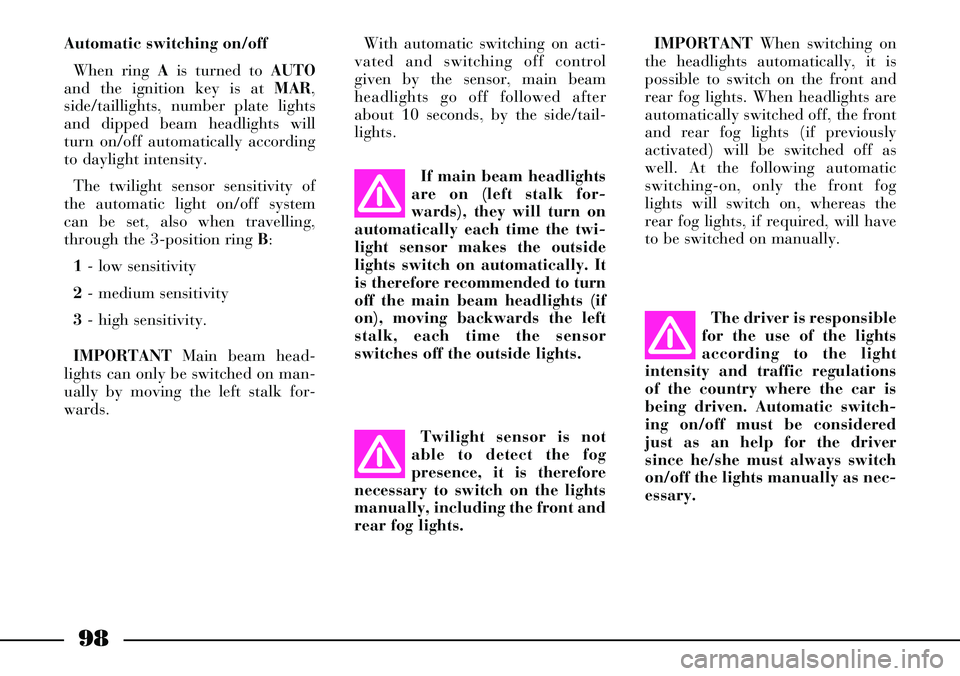
98
Automatic switching on/off
When ring Ais turned to AUTO
and the ignition key is at MAR,
side/taillights, number plate lights
and dipped beam headlights will
turn on/off automatically according
to daylight intensity.
The twilight sensor sensitivity of
the automatic light on/off system
can be set, also when travelling,
through the 3-position ring B:
1- low sensitivity
2- medium sensitivity
3- high sensitivity.
IMPORTANTMain beam head-
lights can only be switched on man-
ually by moving the left stalk for-
wards.If main beam headlights
are on (left stalk for-
wards), they will turn on
automatically each time the twi-
light sensor makes the outside
lights switch on automatically. It
is therefore recommended to turn
off the main beam headlights (if
on), moving backwards the left
stalk, each time the sensor
switches off the outside lights.
Twilight sensor is not
able to detect the fog
presence, it is therefore
necessary to switch on the lights
manually, including the front and
rear fog lights.The driver is responsible
for the use of the lights
according to the light
intensity and traffic regulations
of the country where the car is
being driven. Automatic switch-
ing on/off must be considered
just as an help for the driver
since he/she must always switch
on/off the lights manually as nec-
essary.With automatic switching on acti-
vated and switching off control
given by the sensor, main beam
headlights go off followed after
about 10 seconds, by the side/tail-
lights.IMPORTANTWhen switching on
the headlights automatically, it is
possible to switch on the front and
rear fog lights. When headlights are
automatically switched off, the front
and rear fog lights (if previously
activated) will be switched off as
well. At the following automatic
switching-on, only the front fog
lights will switch on, whereas the
rear fog lights, if required, will have
to be switched on manually.
Page 112 of 386
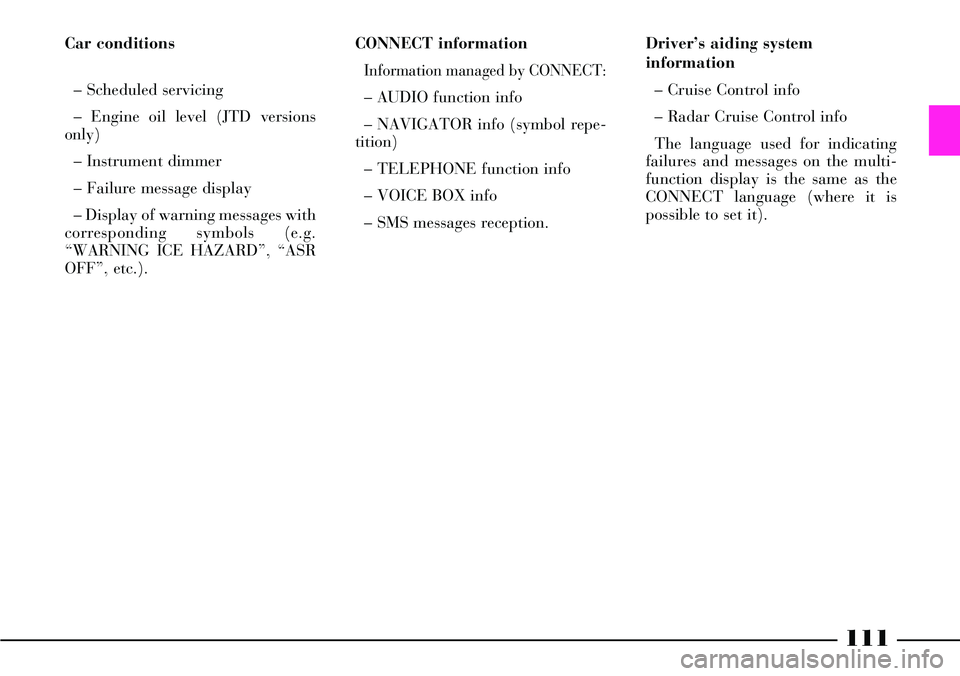
111
Driver’s aiding system
information
– Cruise Control info
– Radar Cruise Control info
The language used for indicating
failures and messages on the multi-
function display is the same as the
CONNECT language (where it is
possible to set it). Car conditions
– Scheduled servicing
– Engine oil level (JTD versions
only)
– Instrument dimmer
– Failure message display
– Display of warning messages with
corresponding symbols (e.g.
“WARNING ICE HAZARD”, “ASR
OFF”, etc.).CONNECT information
Information managed by CONNECT:
– AUDIO function info
– NAVIGATOR info (symbol repe-
tition)
– TELEPHONE function info
– VOICE BOX info
– SMS messages reception.
Page 116 of 386

INSTRUMENT
PANEL WARNING
LIGHTS AND
MESSAGES
On the instrument panel are set the
main warning lights. Certain warn-
ing lights with the relevant warning
messages are present also on the
instrument panel multifunction dis-
play.
Many indications/info are displayed
with a symbol only on the multifunc-
tion display with the corresponding
warnings for the driver.
IMPORTANTIndications may
vary according to the car version.GENERAL NOTES
Failure indications shown on the
multifunction display together with
buzzer sounding and warning light
(if any), are accompanied by spe-
cific warning messages(e.g. “GO
TO DEALER”, “SWITCH OFF
ENGINE”, etc.). These indications
are conciseand cautionaryand are
aimed to suggest the prompt action
the driver must adopt when a car
malfunctioning appears. These indi-
cations, however, shall not be con-
sidered as exhaustive and/or as an
alternative to the specifications con-
tained in this Owner Handbook,
which shall always be read through
carefully and thoroughly. In case of
failure indication always refer to
the specifications contained in
this chapter.Failure indications displayed on
the multifunction display are divid-
ed into two categories: very serious
failures and serious failures. The
message and the warning indication
corresponding to very serious fail-
ures are displayed alternately for
few seconds. This “cycle” is repeat-
ed indefinitely and it stops any pre-
vious indication on the display. It is
displayed every time the ignition key
is turned to MAR, until the cause of
malfunctioning is removed. To stop
this “cycle”, briefly press (less than
two seconds) the trip meter reset
button. In this case the failure sym-
bol stays on the display in the cen-
tral area until the cause of malfunc-
tioning is removed.
115
Page 117 of 386
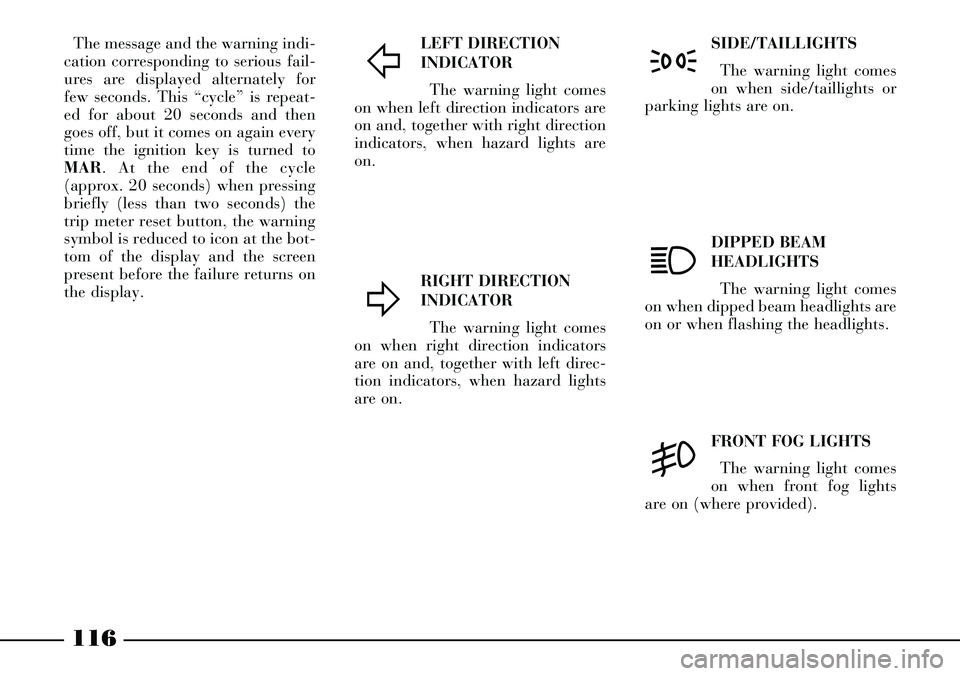
116
LEFT DIRECTION
INDICATOR
The warning light comes
on when left direction indicators are
on and, together with right direction
indicators, when hazard lights are
on.
RIGHT DIRECTION
INDICATOR
The warning light comes
on when right direction indicators
are on and, together with left direc-
tion indicators, when hazard lights
are on.SIDE/TAILLIGHTS
The warning light comes
on when side/taillights or
parking lights are on.
DIPPED BEAM
HEADLIGHTS
The warning light comes
on when dipped beam headlights are
on or when flashing the headlights.
FRONT FOG LIGHTS
The warning light comes
on when front fog lights
are on (where provided).
Ÿ
∆
3
1
5
The message and the warning indi-
cation corresponding to serious fail-
ures are displayed alternately for
few seconds. This “cycle” is repeat-
ed for about 20 seconds and then
goes off, but it comes on again every
time the ignition key is turned to
MAR. At the end of the cycle
(approx. 20 seconds) when pressing
briefly (less than two seconds) the
trip meter reset button, the warning
symbol is reduced to icon at the bot-
tom of the display and the screen
present before the failure returns on
the display.
Page 119 of 386
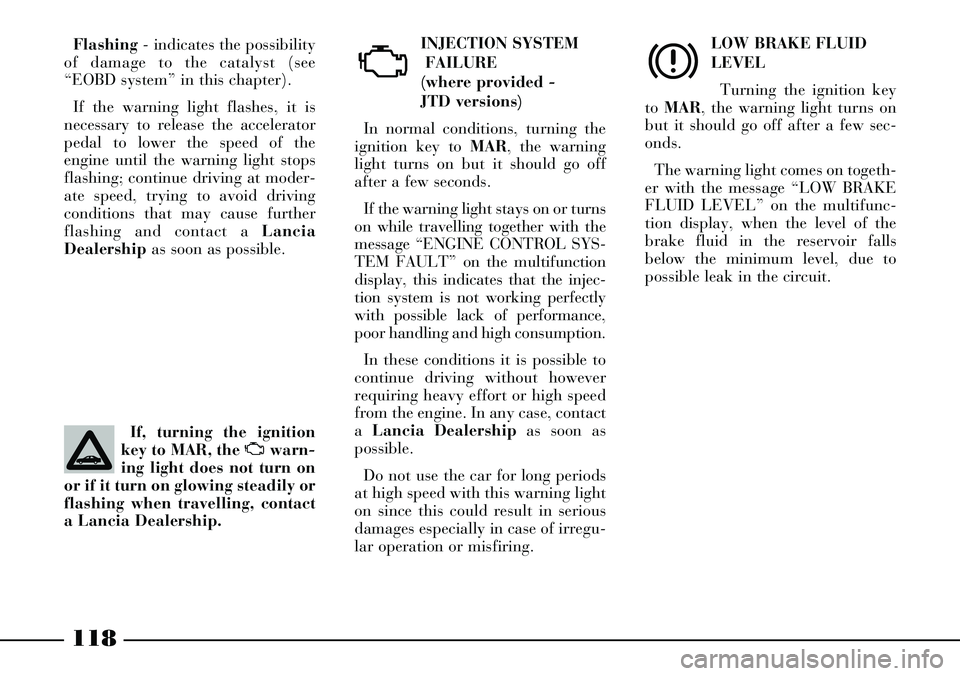
LOW BRAKE FLUID
LEVEL
Turning the ignition key
to MAR, the warning light turns on
but it should go off after a few sec-
onds.
The warning light comes on togeth-
er with the message “LOW BRAKE
FLUID LEVEL” on the multifunc-
tion display, when the level of the
brake fluid in the reservoir falls
below the minimum level, due to
possible leak in the circuit.
118
INJECTION SYSTEM
FAILURE
(where provided -
JTD versions)
In normal conditions, turning the
ignition key to MAR, the warning
light turns on but it should go off
after a few seconds.
If the warning light stays on or turns
on while travelling together with the
message “ENGINE CONTROL SYS-
TEM FAULT” on the multifunction
display, this indicates that the injec-
tion system is not working perfectly
with possible lack of performance,
poor handling and high consumption.
In these conditions it is possible to
continue driving without however
requiring heavy effort or high speed
from the engine. In any case, contact
a Lancia Dealershipas soon as
possible.
Do not use the car for long periods
at high speed with this warning light
on since this could result in serious
damages especially in case of irregu-
lar operation or misfiring.
Ux
Flashing- indicates the possibility
of damage to the catalyst (see
“EOBD system” in this chapter).
If the warning light flashes, it is
necessary to release the accelerator
pedal to lower the speed of the
engine until the warning light stops
flashing; continue driving at moder-
ate speed, trying to avoid driving
conditions that may cause further
flashing and contact a Lancia
Dealershipas soon as possible.
If, turning the ignition
key to MAR, the Uwarn-
ing light does not turn on
or if it turn on glowing steadily or
flashing when travelling, contact
a Lancia Dealership.
Page 121 of 386

120
ESP SYSTEM (ELEC-
TRONIC STABILITY
PROGRAM) FAILURE
Turning the ignition key to MAR,
the warning light turns on but it
should go off after a few seconds.
If the warning light does not go off
or stays on when travelling together
with the message “ESP SYSTEM
FAULT” on the multifunction dis-
play, contact a Lancia Dealership.
Warning light flashing when dri-
ving indicates that the ESP system is
active.
In the event of instrument panel
warning light failure, the warning
light on the multifunction display
comes on together with message
“ESP INDICATOR FAULT”: con-
tact a Lancia Dealershipas soon
as possible.ELECTRIC PARKING
BRAKE (EPB)
Turning the ignition key
to MAR, the warning light turns on
but it should go off after a few sec-
onds.In case of xinstrument panel
warning light failure, 3warning
light comes on together with mes-
sage “EPB INDICATOR FAULT -
GO TO DEALER” on the multifunc-
tion display: contact a Lancia
Dealershipas soon as possible.
áx
If the xwarning light
does not go off or stays on
when travelling together
with the message “EPB FAULT -
GO TO DEALER” on the instru-
ment panel display, contact
immediately a Lancia
Dealership.
Page 122 of 386

MULTIFUNCTION DISPLAY
WARNING LIGHTS AND
MESSAGES
The following pages give a list of
monitored car systems or parame-
ters and the corresponding symbols,
failure and warning messages that
could be shown on the multifunction
display.
The following tables show the fail-
ure/warning indications with the
corresponding meaning and the
proper actions to take.
Indications may vary according to
the car version.Screen A(failure message) and B
(warning message) (fig. 111) are an
example of the indications displayed
alternately.
fig. 111
L0A0240g
121